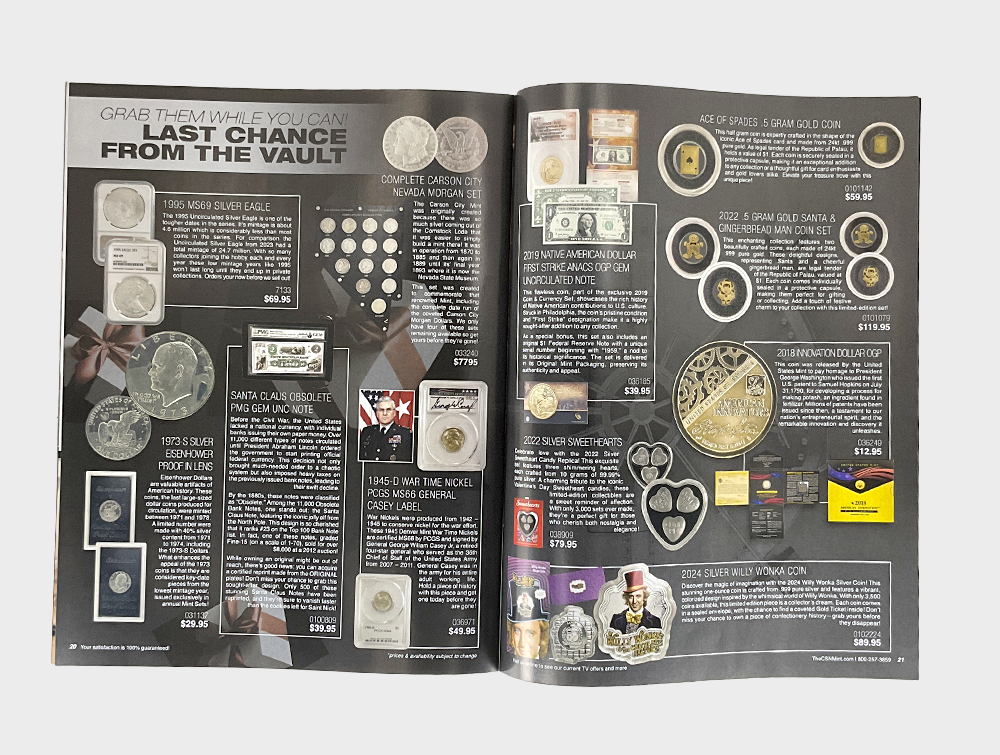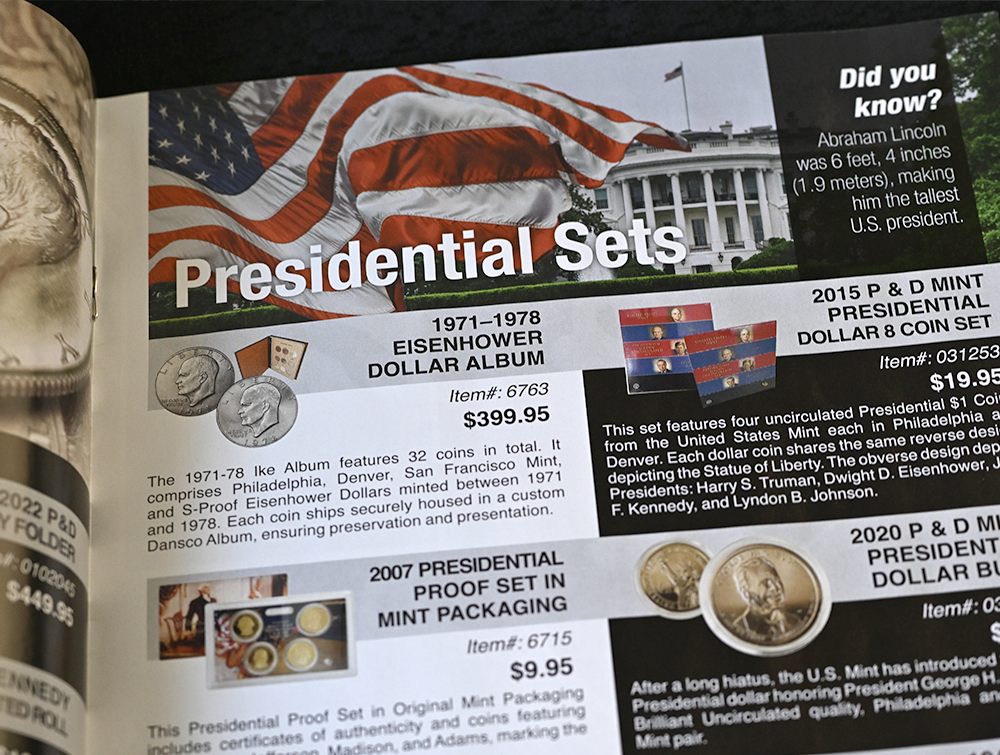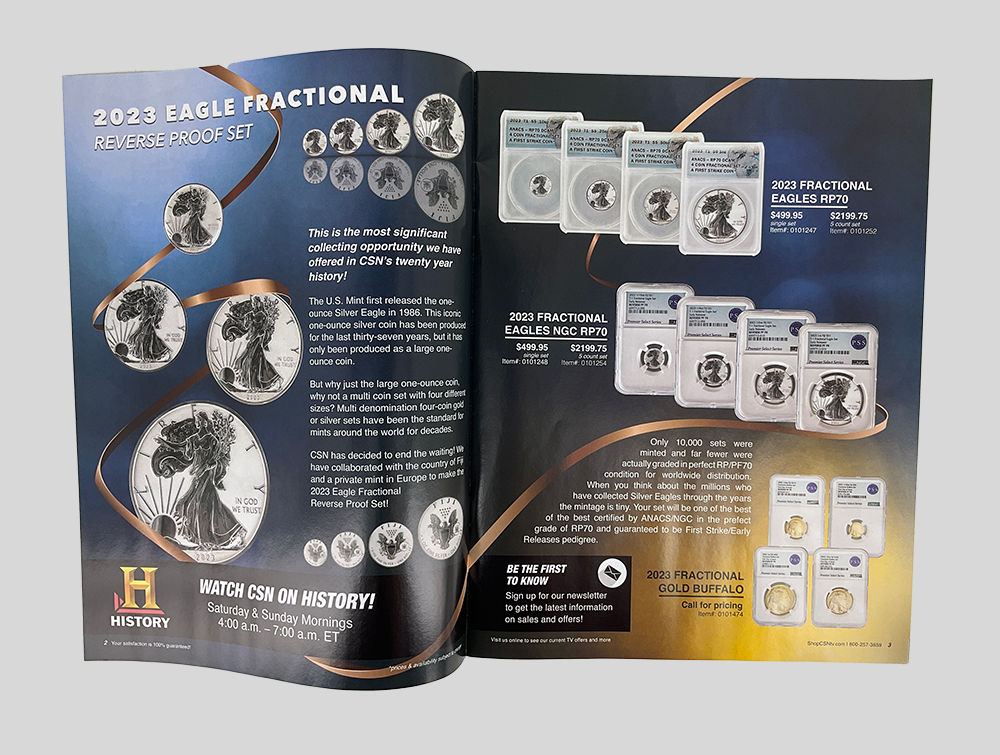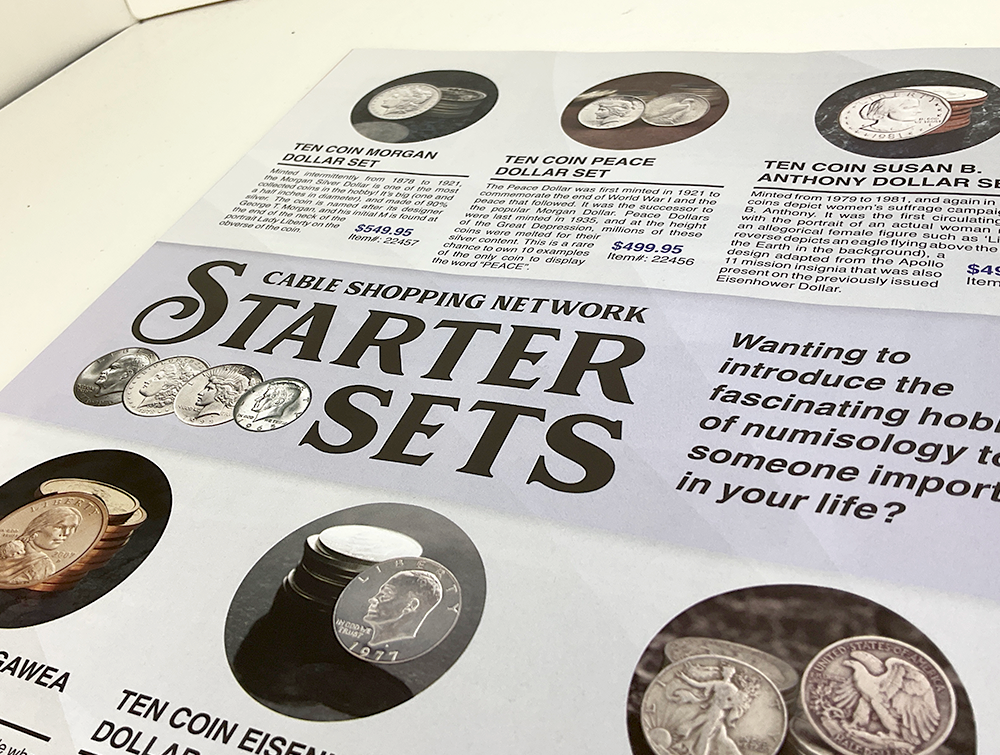Catalog Design
In my role with Cable Shopping Network, the catalog is the largest project I did. I designed 6 catalogs - 5 are shown here, with the 6th soon to be distributed to customers. These catalogs are timed to reach customer hands leading up to peak sales months in the summer and fall. The content for each catalog remains relatively the same, so the main challenge for each catalog is refreshing the layout and design.
The target demographic in the numismatic (coin collecting) industry is middle aged to older males. The general branding guidelines for the company are using colors within a more masculine color scheme like blues, purples, and reds. Imagery leans more towards upscale, masculine, and modern. The company leans more conservative in values so the use of directly Christmas themed collateral, and less holiday neutral imagery made more sense for the holiday catalogs.
A secondary demographic to CSN are people new to the hobby. I had a unique perspective coming from outside the industry and use it often to point out ways we can help relate to our current market and target new numismatic enthusiasts. I did this by creating space in the categories for educational elements. Fun facts, broad historical references, and small details help make it so anyone from an experienced hobbyist to a random person off the street could pick up our catalog and be drawn in.
Process
In continuing the theme of minimal design and large imagery, this catalog was based around the theme of elements of Americana. I focused on the American flag, blues that made the silver pieces pop, and greens and purples that made the gold items pop. With each catalog, there are spreads that are repeated so I have to find ways to refresh the layout, or show the same items in a different way. For example, in this catalog I was able to add in the obverse and reverse of each coin along with stacks of coins to better show the value when a customer would purchase a 10 coin bundle from our starter sets spreads.
For the typical process, layout comes first. Usually spreads are pretty straightforward with content, but sometimes our Product Director pulls a seemingly random collection of products for a spread based on availability and other factors. For example, in this catalog there was a section dedicated to a combination of John F Kennedy items and other U.S. presidents. There weren’t enough items to make the sole focus and hierarchy about Kennedy, so instead I focused on the individual important historical contributions of each of the presidents included. This transformed the seemingly random collection of products into a story for customers to invest in and purchase. Situations like these have created interesting design challenges!
Process
The theme for this holiday catalog was to push to a more high scale demographic. In the higher demographics, you typically see much more minimal design. Each page in a catalog is worth thousands of dollars based on how much it costs to produce a catalog, so any white space/minimalism shows the money an organization has to spend, i.e. their success. With this in mind, I chose very simple backgrounds with lush fabrics and textures to edit coins on. The large imagery would be the focal point of each spread and by limiting the number of items on each spread, I’d reduce clutter and make it easier for customers to find what we wanted them to find.
For this catalog I experimented with AI image tools to see what the capabilities were, and if they would be realistically usable in print. Given the limited amount of time for each catalog, it’s not possible to do proper photoshoots with product - I would normally have to use background images from Shutterstock and edit in product with shadowing. I was interested to see if I could pull more specific imagery with the AI tools. My results were mixed - sometimes I would get a really excellent image, but the resolution was so low it was unusable. Or I’d get a high resolution image with obvious markers of it being made with AI like elements not properly rendering, or only rendering part of an object so it just didn’t look right. It was a useful experiment and showed how much of a useful tool AI can be for short turn arounds, but it definitely isn’t a substitute for the real thing and ultimately needs a designer’s oversight.
Creating a Process
When I joined the team, I asked for details on previous catalogs and their typical guidelines, process, and timeline. The catalog in the past had traded hands often between designers and who was the project lead. Therefore the actual process depended on who was working on it so ultimately I was creating the process from scratch.
While my manager worked with the product manager to collect the products to be included, I looked through previous catalogs and figured out the spreads that were consistently used in order to have a starting point. Between the 3 of us we filled up 22 pages with products and I was able to get to work.
Timeline
From start to finish, the printed piece in this project was completed in 9 weeks. This included all design, all layout, all edits and revisions. I am the graphic designer and merchandise photographer so any items that weren’t photographed needed to be taken and edited for the catalog.
After the printed piece was completed, I then made sure each item in the catalog had corresponding web images. My manager added whichever items were missing to the website and I was able to take each of these pages to make a linked up digital version of the catalog.
Process Evolution
Once the first catalog was completed, I was able to review my experience and asked for feedback from the different departments involved. The general theme of each catalog is discussed in very loose ideas, which I then take and build a mood board & collect concept ideas to build from. I pitch the concepts to the head of my department and once the aesthetic of the catalog is decided, I’m able to design the creative elements to compliment the layout for each spread.
Typical Timeline
The timeline for this project has varied from 9-12 weeks depending on how quickly I’m able to receive the outline from upper management. I have taken over the entire process of this project, relying on my supervisor for general art direction and copy editing. As the sole graphic designer, merchandise photographer, and website product manager of the organization, it is my responsibility to take every photo of items included in the catalog and website, along with all design, layout, edits, and revisions. My role has expanded to building web pages for each product to include basic information about items (FAQs) along with more detailed descriptions. There is a digital version of the catalog loaded to our website as well that I link and every item to and ensure is trackable.










































